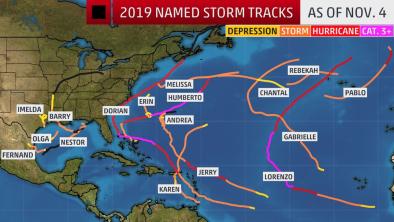A new top killer emerges in hurricanes, and many blame climate change

Ask anyone the most dangerous element of a hurricane, and they may mention wind. They may mention storm surge. But they’re unlikely to name the biggest current killer: rain.
In the past three years, as the impact of climate change on hurricanes became more apparent, rain has pushed aside storm surge to emerge as the top source of deaths.
About 75 percent of the 162 fatalities in hurricanes and other tropical cyclones striking the United States from 2016 to 2018 were caused by rain-induced flooding, with most victims drowning in or near their vehicles, according to the National Hurricane Center. The number excludes the toll from Hurricane Maria, which dumped enormous quantities of rain on Puerto Rico, because of uncertainties in the death count.
The fatalities occurred in a series of particularly wet hurricanes that set state and national rainfall records. Topping these was Hurricane Harvey, a 2017 storm that brought more than 60 inches of rain to parts of southeastern Texas, setting a U.S. record for tropical weather systems. Torrents of water swept away cars, carried off drivers attempting to escape on foot, and threw vehicles off low-lying bridges.
...
“I think we’re at the beginnings of the new normal,” said Ben Kirtman, director of the Center for Computational Science Climate and Environmental Hazards Program at the University of Miami’s Rosenstiel School for Marine and Atmospheric Science.
“It’s pretty simple. A warmer atmosphere holds more water vapor. And so when it comes time to condense all that water vapor and produce rainfall, there’s more water vapor available. The second element is the engine for tropical storms; the energy source for that engine is warm ocean surface temperatures, and those have risen. As the climate system warms, the ocean warms. That means there’s more fuel for these hurricanes, which can lead to enhanced rainfall.”
Several studies attribute Harvey’s torrential rain at least partly to climate change. A 2017 study by scientists at the Lawrence Berkeley National Laboratory found that climate change probably increased the hurricane’s rains in the Houston area by up to 38 percent.
...
Suzana Camargo, executive director of the Initiative on Extreme Weather and Climate at Columbia University, said all the studies that examined Harvey’s rainfall and climate change found a link, differing only in the percentage of the rain they attributed to climate change.
“You’d expect with a warmer atmosphere you can hold more water vapor so you’d have more rainfall, so it’s not surprising that we can start seeing that in relation to hurricanes as well,” she said. “That was one of the projections that we’d see by the end of the 21st century, but now in some specific hurricanes, we’re starting to see it. The projections are for an increase on the order of 20 percent by the end of the century. But you see already that you can see the signal starting to appear in these storms.”
Related Content





